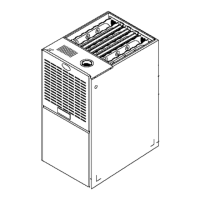ofbeingclosedoff.VentilationopeningstooutdoorsMUSTbeat
least1squareinch(25mm2)offreeareaper4,000BTUHoftotal
inputratingforallgasappliancesinarea.
Inunconfinedspaces,infiltrationshouldbeadequatetoprovide
airforcombustion,ventilationanddilutionoffluegases.However,
inbuildingswithunusuallytightconstruction,additionalairMUST
beprovidedusingthemethodsdescribedinsectiontitledCon-
fined Space Installation:
Unusually tight construction is defined as: Construction with
1 Walls and ceilings exposed to the outside have a continuous,
sealed vapor barrier. Openings are gasketed or sealed and
3. GasVentInstallation
Poison carbon monoxide gas, fire and explo-
sion hazard.
2 Doors and openable windows are weather stripped and
Other openings are caulked or sealed. These include joints
around window and door frames, between sole plates and
floors, between wall-ceiling joints, between wall panels, at
penetrations for plumbing, electrical and gas lines, etc.
Ventilation Air
Some provincial codes and local municipalities require ventilation
or make-up air be brought into the conditioned space as replace-
ment air. Whichever method is used, the mixed return air temper-
ature across the heat exchanger MUST not fall below 60°F (15° c)
or flue gases will condense in the heat exchanger. This will short-
en the life of the heat exchanger and possibly void your warranty.
lined in the GAMA venting tables or Masonry Chimney
section in these instructions.
Read and follow all instructions in this section.
Failure to properly vent this furnace can result in
property damage, personal injury and/or death.
Install the vent in compliance with codes of the country having ju-
risdiction and the GAMA venting tables, local codes or ordi-
nances and these instructions.
These fan assisted combustion furnaces have been classified as
Category ][appliances which means that they MUST operate with
a negative vent pressure.
CategoryI SafeVenting Requirements
NOTE: The following instructions comply with the United States
National Fuel Gas Code.
If a Category ][vent passes through an attic, any concealed
space or floor, use ONLY Type B or Type L double wall vent
pipe. If vent pipe passes through interior wall, use type B vent
pipe with ventilated thimble ONLY.
2. Do NOT vent furnace into any chimney serving an open fire-
place or solid fuel burning appliance.
3. Use the same diameter Category ][connector or pipe as per-
mitted by the GAIVlA venting tables.
4. Keep vertical Category ][vent pipe or vent connector runs as
short and direct as possible.
5. Vertical outdoor runs of type B or ANY single wall vent pipe
below the roof line are NOT permitted.
6. Slope all horizontal runs up away from furnace a minimum of
!/4" (6mm) per foot.
7. Support all horizontal vent pipe every 6' (2m) using proper
clamps and metal straps.
8. Check existing gas vent or chimney to ensure they meet
clearances and local codes.
9. The furnace MUST be connected to a factory built chimney or
vent complying with a recognized standard. Venting into a
masonry or concrete chimney is only permitted as out-
Poison carbon monoxide gas hazard.
If this furnace is replacing a previously
common-vented furnace, it may be necessary
to resize the existing chimney liner or vent to
prevent over sizing problems for the other
remaining appliances(s). See codes of country
having jurisdiction.
Failure to properly vent this furnace or other
appliances can result in property damage,
personal injury and/or death.
Venting and CombustionAir Check
NOTE: If this installation removes an existing furnace from a vent-
ing system serving one or more other appliances, and to make
sure there is adequate combustion air for all appliances, MAKE
THE FOLLOWING CHECK.
1. Seal any unused openings in the venting system.
Visually inspect the venting system for proper size and hori-
zontal pitch to ensure there is no blockage or restriction, leak-
age, corrosion or other deficiencies which could cause an
unsafe condition.
Insofar as is practical, close all doors and windows and all
doors between the space in which the appliance(s) remain-
ing connected to the venting system are located and other
spaces of the building.
Turn on clothes dryers and any appliance not connected to
the venting system. Turn on any exhaust fans, such as range
hoods and bathroom exhausts, so they will operate at maxi-
mum speed. Do not operate a summer exhaust fan. Close
fireplace dampers.
5. Follow the lighting instructions for each appliance being in-
spected. Adjust thermostat so appliance(s) will operate con-
tinuously.
6. Allow 5 minutes of main burner operation, then check for
spillage at the draft hood relief opening of each appliance.
Use the flame of a match or candle (Figure 5).

